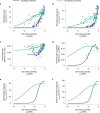Towards a unified theory of plant photosynthesis and hydraulics
- PMID: 36303010
- PMCID: PMC9663302
- DOI: 10.1038/s41477-022-01244-5
Towards a unified theory of plant photosynthesis and hydraulics
Abstract
The global carbon and water cycles are governed by the coupling of CO2 and water vapour exchanges through the leaves of terrestrial plants, controlled by plant adaptations to balance carbon gains and hydraulic risks. We introduce a trait-based optimality theory that unifies the treatment of stomatal responses and biochemical acclimation of plants to environments changing on multiple timescales. Tested with experimental data from 18 species, our model successfully predicts the simultaneous decline in carbon assimilation rate, stomatal conductance and photosynthetic capacity during progressive soil drought. It also correctly predicts the dependencies of gas exchange on atmospheric vapour pressure deficit, temperature and CO2. Model predictions are also consistent with widely observed empirical patterns, such as the distribution of hydraulic strategies. Our unified theory opens new avenues for reliably modelling the interactive effects of drying soil and rising atmospheric CO2 on global photosynthesis and transpiration.
© 2022. The Author(s).
Conflict of interest statement
The authors declare no competing interests.
Figures





Similar articles
-
A stomatal optimization theory to describe the effects of atmospheric CO2 on leaf photosynthesis and transpiration.Ann Bot. 2010 Mar;105(3):431-42. doi: 10.1093/aob/mcp292. Epub 2009 Dec 8. Ann Bot. 2010. PMID: 19995810 Free PMC article.
-
Incorporating photosynthetic acclimation improves stomatal optimisation models.Plant Cell Environ. 2024 Sep;47(9):3478-3493. doi: 10.1111/pce.14891. Epub 2024 Apr 8. Plant Cell Environ. 2024. PMID: 38589983
-
Predicting stomatal responses to the environment from the optimization of photosynthetic gain and hydraulic cost.Plant Cell Environ. 2017 Jun;40(6):816-830. doi: 10.1111/pce.12852. Epub 2016 Dec 21. Plant Cell Environ. 2017. PMID: 27764894
-
Photosynthesis - beyond the leaf.New Phytol. 2023 Apr;238(1):55-61. doi: 10.1111/nph.18671. Epub 2023 Jan 6. New Phytol. 2023. PMID: 36509710 Free PMC article. Review.
-
Extreme undersaturation in the intercellular airspace of leaves: a failure of Gaastra or Ohm?Ann Bot. 2022 Sep 19;130(3):301-316. doi: 10.1093/aob/mcac094. Ann Bot. 2022. PMID: 35896037 Free PMC article. Review.
Cited by
-
Artificial cellulosic leaf with adjustable enzymatic CO2 sequestration capability.Nat Commun. 2024 Jun 8;15(1):4898. doi: 10.1038/s41467-024-49320-y. Nat Commun. 2024. PMID: 38851785 Free PMC article.
-
Evidence for the acclimation of ecosystem photosynthesis to soil moisture.Nat Commun. 2024 Nov 12;15(1):9795. doi: 10.1038/s41467-024-54156-7. Nat Commun. 2024. PMID: 39532886 Free PMC article.
-
Uniform regulation of stomatal closure across temperate tree species to sustain nocturnal turgor and growth.Nat Plants. 2025 Apr;11(4):725-730. doi: 10.1038/s41477-025-01957-3. Epub 2025 Apr 3. Nat Plants. 2025. PMID: 40181103 Free PMC article.
-
Precision phenotyping of a barley diversity set reveals distinct drought response strategies.Front Plant Sci. 2024 Jun 24;15:1393991. doi: 10.3389/fpls.2024.1393991. eCollection 2024. Front Plant Sci. 2024. PMID: 38984164 Free PMC article.
-
The Long-Term Effects of Barren Land Afforestation on Plant Productivity, Soil Fertility, and Soil Moisture in China: A Meta-Analysis.Plants (Basel). 2024 Jun 11;13(12):1614. doi: 10.3390/plants13121614. Plants (Basel). 2024. PMID: 38931046 Free PMC article.
References
-
- Raschke K, Monteith JL, Weatherley PE. How stomata resolve the dilemma of opposing priorities. Phil. Trans. R. Soc. Lond. B. 1976;273:551–560. doi: 10.1098/rstb.1976.0031. - DOI
MeSH terms
Substances
LinkOut - more resources
Full Text Sources
Other Literature Sources

